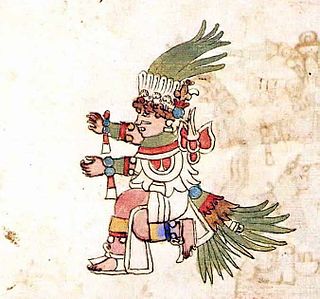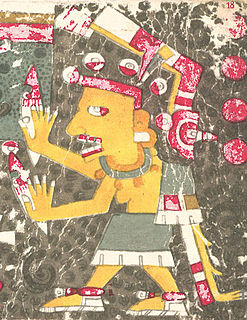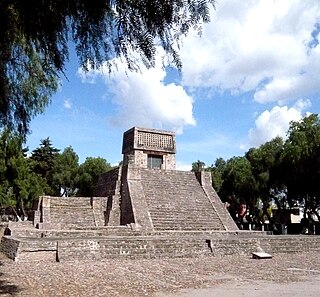 W
WAhuiateteo [awiateteo] or Macuiltonaleque [makʷiɬtonaleke] were a group of five Aztec gods of excess and pleasure. They also represented the dangers that come along with these. These five gods were also invoked by diviners and mystics. They were associated with the Tzitzimimeh, a group of frightening beings that personified death, drought, and war.
 W
WIn Aztec mythology, Atlahua, Ahtlahua, Atlahoa, Atlavâ or Atlaua [aˈtɬawa] was a water goddess, fishermen and archer. There were said to be at least four ancient Aztec temples at which he was worshiped, the tallest supposedly being over 200 feet tall. The Aztecs prayed to him when there were deaths in water, such as when Hernando Cortez conquered Tenochtitlan, and the lake was said to be "floating with heads and corpses".
 W
WIn Aztec mythology, the Centzon Tōtōchtin are a group of divine rabbits who meet for frequent drunken parties. They include Tepoztecatl, Texcatzonatl, Colhuatzincatl, Macuiltochtli ("five-rabbit"), and Ometochtli ("two-rabbit"). Their parents are Patecatl and Mayahuel and they may be brothers of Ixtlilton.
 W
WIn Aztec mythology, the Centzonhuītznāhua were the gods of the southern stars. They are the elder sons of Cōātlīcue, and their sister is Coyolxāuhqui. They and their sister tried to murder their mother upon learning of her pregnancy with Huītzilōpōchtli; their plan was thwarted when their brother sprang from the womb—fully grown and garbed for battle—and killed them all.
 W
WIn Aztec mythology, Chalchiuhtotolin was a god of disease and plague. Chalchihuihtotolin, the Jewelled Fowl, Tezcatlipoca's nahual. Chalchihuihtotolin is a symbol of powerful sorcery. Tezcatlipoca can tempt humans into self-destruction, but when he takes his turkey form he can also cleanse them of contamination, absolve them of guilt, and overcome their fate. In the tonalpohualli, Chalchihuihtotolin rules over day Tecpatl and over trecena 1-Atl (Water).
 W
WIn Aztec mythology, Chicomecōātl [t͡ʃikomeˈkoːaːt͡ɬ] "Seven Serpent", was the Aztec goddess of agriculture during the Middle Culture period. She is sometimes called "goddess of nourishment", a goddess of plenty and the female aspect of maize.
 W
WCipactli was the first day of the Aztec divinatory count of 13 X 20 days and Cipactonal "Sign of Cipactli" was considered to have been the first diviner. In Aztec cosmology, the crocodile symbolized the earth floating in the primeval waters. According to one Aztec tradition, Teocipactli "Divine Crocodile" was the name of a survivor of the flood who rescued himself in a canoe and again peopled the earth. In the Mixtec Vienna Codex, Crocodile is a day associated with dynastic beginnings.
 W
WIn Mixtec mythology, Dzahui or Dzavui was the god of rain. Child sacrifices were performed for Dzahui on the tops of hills during times of drought, sickness, and at harvest time.
 W
WPrincess Eréndira of the Purépecha was the princess of the Purépecha from about 1503–1519.
 W
WHuehueteotl WAY-way-TAY-oh-təl; Nahuatl pronunciation: [weːweˈteoːt͡ɬ] is an aged Mesoamerican deity figuring in the pantheons of pre-Columbian cultures, particularly in Aztec mythology and others of the Central Mexico region. The spellings Huehuetéotl and Ueueteotl are also used. Although known mostly in the cultures of that region, images and iconography depicting Huehueteotl have been found at other archaeological sites across Mesoamerica, such as in the Gulf region, western Mexico, Protoclassic-era sites in the Guatemalan highlands such as Kaminaljuyú and Late-Postclassic sites on the northern Yucatán Peninsula. The name Huehueteotl stems from Nahuatl huēhueh [ˈweːweʔ] ("old") and teōtl [ˈteoːt͡ɬ] ("god"). It seems to connect the Old God to certain Mayan deities called Mam ("Grandfather").
 W
WIn Aztec mythology, Itztlacoliuhqui is the god of frost. He also represents matter in its lifeless state.
 W
WIn Aztec mythology, Metztli was a god or goddess of the moon, the night, and farmers. She or they were probably the same deity as Yohaulticetl and Coyolxauhqui and the male moon god Tecciztecatl; like the latter, she feared the Sun because she feared its fire. Also referred to as the lowly god of worms who failed to sacrifice himself to become the Sun, and became the Moon instead, his face darkened by a rabbit.
 W
WMexitli, Mexi, or Mezih was a legendary great leader and war priest of the Aztecs during the wandering years. According to Bernardino de Sahagún, the name derives from the Nahuatl metl and zitli.
 W
WIn Aztec mythology, Mictēcacihuātl is Queen of Mictlān, the underworld, ruling over the afterlife with Mictlāntēcutli, another deity who is her husband.
 W
WMictlan is the underworld of Aztec mythology. Most people who die would travel to Mictlan, although other possibilities exist.. Mictlan consists of nine distinct levels.
 W
WIn Aztec mythology, Ometochtli is the collective or generic name of various individual deities and supernatural figures associated with pulque, an alcoholic beverage derived from the fermented sap of the maguey plant. By the Late Postclassic period of Mesoamerican chronology a collection of beliefs and religious practices had arisen in the context of the manufacture and ritualistic consumption of the beverage, known as the "pulque cult" with probable origins in a mountainous region of central Mexico. In Aztec society octli rituals formed a major component of Aztec religion and observance, and there were numerous local deities and classes of sacerdotes ("priests") associated with it.
 W
WIn Aztec religion, Painal was sometimes interpreted by Spanish colonists as a god (teotl) who served as a representative of Huitzilopochtli. Other scholars have noted that Paynala may have been a toponym, confused for a person.
 W
WIn Aztec mythology, Patecatl is a god of healing and fertility and the discoverer of peyote as well as the "lord of the root of pulque". With Mayahuel, he was the father of the Centzon Totochtin.
 W
WIn Aztec mythology, Tecciztecatl was a lunar deity, representing the "man-in-the-moon".
 W
WIn Aztec mythology, Tepēyōllōtl Nahuatl pronunciation: [tepeːˈju˕ːɬːu˕ːtɬ] was the god of earthquakes, echoes and jaguars. He is the god of the Eighth Hour of the Night, and is depicted as a jaguar leaping towards the sun. In the calendar, Tepeyollotl rules over both the third day, Calli (house), and the third trecena, 1-Mazatl (deer). He is the eighth Lord of the Night.
 W
WTlacotzontli is an Aztec god of roads.
 W
WIn Aztec mythology, Tonacatecuhtli was a creator and fertility god, worshiped for peopling the earth and making it fruitful. Most Colonial-era manuscripts equate him with Ōmetēuctli. His consort was Tonacacihuatl.
 W
WIn Nahuatl, Tonantzin is a title composed of to- "our" + nān "mother" + -tzin "(honorific suffix)". When addressing Tonantzin directly, males use the suffixed vocative form Tonāntziné [] while females use the unsuffixed vocative form Tonāntzín []
 W
WZacatzontli, in Aztec mythology, is the god of day road, he has an eagle as sun's symbol guide. He holds in his left hand a staff and his right hand supports an backpack full of quetzals. He can be a protector of merchants, thus equating him with the Mayan god Ek Chuáj. He also helps travellers making him like Jokõjin and Jizu in Japanese mythology. One of the odd things about Zacatzontli is that he doesn't have a headdress, only a feather. His name could mean Lord of the Road or His Road The Lord, although the former seems more likely.